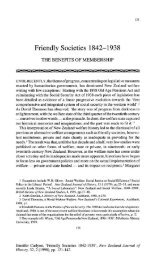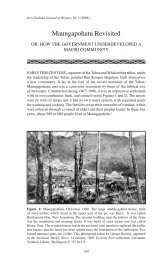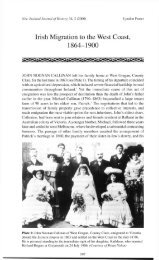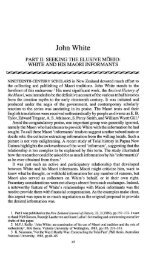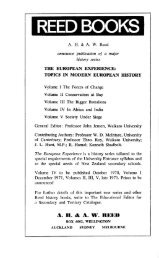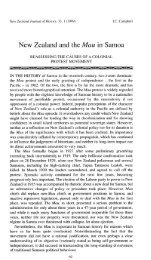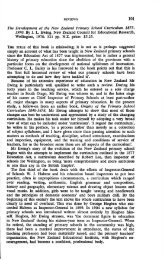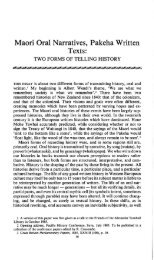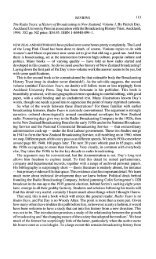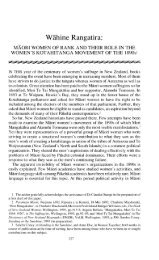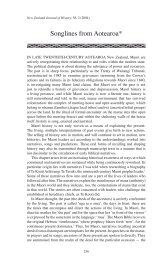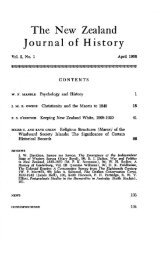Bishop G. A. Selwyn and the Melanesian Mission - New Zealand ...
Bishop G. A. Selwyn and the Melanesian Mission - New Zealand ...
Bishop G. A. Selwyn and the Melanesian Mission - New Zealand ...
You also want an ePaper? Increase the reach of your titles
YUMPU automatically turns print PDFs into web optimized ePapers that Google loves.
BISHOP G. A. SELWYN AND THE MELANESIAN MISSION 121<br />
<strong>Selwyn</strong> ultimately based his claim to spiritual responsibility for <strong>the</strong><br />
<strong>Melanesian</strong> isl<strong>and</strong>s. As early as 1842, prompted by <strong>Bishop</strong> Broughton<br />
of Sydney, he was toying with <strong>the</strong> idea of a central missionary college<br />
in <strong>New</strong> Zeal<strong>and</strong> with pupils drawn from all parts of <strong>the</strong> South<br />
Pacific, 4 a <strong>the</strong>me to which he returned in <strong>the</strong> Charge to his second<br />
synod in 1847. 5 There is little doubt that <strong>Selwyn</strong> would have<br />
embarked upon this scheme without delay but for external hindrances:<br />
acrimonious wranglings with <strong>the</strong> independent-minded agents of <strong>the</strong><br />
Church <strong>Mission</strong>ary Society over <strong>the</strong> internal organization of <strong>the</strong> Maori<br />
mission, Hone Heke's rebellion, <strong>and</strong> <strong>the</strong> lack of assistant clergy who<br />
shared his fundamental viewpoint <strong>and</strong> whom he felt he could trust. 6<br />
His opportunity finally came in December 1847 when he was able to<br />
visit <strong>the</strong> isl<strong>and</strong>s for <strong>the</strong> first time as acting-chaplain to <strong>the</strong> cruising<br />
warship H.M.S. Dido. This ten weeks' voyage was to be of seminal<br />
importance in <strong>the</strong> evolution of a strategy for his proposed mission.<br />
<strong>Selwyn</strong>'s visit to Samoa was particularly significant. As a High<br />
Churchman he regarded non-episcopal bodies as lying outside <strong>the</strong><br />
Church. Never<strong>the</strong>less, he was a warm admirer of <strong>the</strong> achievements<br />
<strong>and</strong> writings of Samoa's pioneer missionary, John Williams of <strong>the</strong><br />
London <strong>Mission</strong>ary Society, who had been killed by natives of<br />
Eromanga in <strong>the</strong> <strong>New</strong> Hebrides in November 1839. Although he<br />
privately deplored <strong>the</strong> evidences of missionary paternalism, he was<br />
impressed by <strong>the</strong> expansive energy of Polynesian Christianity <strong>and</strong> <strong>the</strong><br />
sending of evangelists to <strong>the</strong> Loyalty Isl<strong>and</strong>s <strong>and</strong> sou<strong>the</strong>rn <strong>New</strong><br />
Hebrides: 'we shall be indeed disgraced, if <strong>the</strong> older <strong>Mission</strong> of <strong>New</strong><br />
Zeal<strong>and</strong> cannot do as much for Melanesia, as its younger brethren<br />
in Samoa <strong>and</strong> Barotonga.' 7 This view was reinforced by his meeting<br />
with John Geddie <strong>and</strong> Isaac Archibald, missionaries from <strong>the</strong> Presbyterian<br />
Church of Nova Scotia, who were waiting in Samoa for a<br />
passage to <strong>the</strong>ir projected new mission field in <strong>the</strong> <strong>New</strong> Hebrides:<br />
'This was a striking lesson for our <strong>New</strong> Zeal<strong>and</strong> Church; for I believe<br />
this was <strong>the</strong> first instance of any Colonial Body sending out its own<br />
<strong>Mission</strong> to <strong>the</strong> hea<strong>the</strong>n, without assistance from <strong>the</strong> mo<strong>the</strong>r country.' 3<br />
From Samoa <strong>and</strong> Tonga <strong>the</strong> Dido sailed westward into Melanesia,<br />
to <strong>the</strong> <strong>New</strong> Hebrides <strong>and</strong> <strong>New</strong> Caledonia. In this part of <strong>the</strong> Pacific<br />
European contact was still in its initial phase. From <strong>the</strong> 1830s whalers<br />
<strong>and</strong> traders for isl<strong>and</strong> produce had called regularly at particular bays<br />
<strong>and</strong> anchorages as far north as <strong>New</strong> Irel<strong>and</strong> <strong>and</strong> <strong>the</strong> Admiralty group,<br />
but it was not until 1841 when s<strong>and</strong>alwood was discovered in quantity<br />
on <strong>the</strong> Isle of Pines, <strong>and</strong> later on adjacent isl<strong>and</strong>s, that trading vessels<br />
* Tucker, I, 129.<br />
5 G. A. <strong>Selwyn</strong>, A Charge delivered to <strong>the</strong> Clergy of <strong>the</strong> Diocese of Nero<br />
Zeal<strong>and</strong> . . . on September 23, 1847, 2nd ed., London, 1849, pp. 19-20.<br />
6 The untimely death in January 1843 of his chaplain, <strong>the</strong> Reverend Thomas<br />
Whytehead, was certainly a factor in <strong>the</strong> delay.<br />
7 G. A. <strong>Selwyn</strong>, Letters on <strong>the</strong> <strong>Melanesian</strong> <strong>Mission</strong> in 1853, London, 1855,<br />
p. 33.<br />
8 ibid., p. 26.



